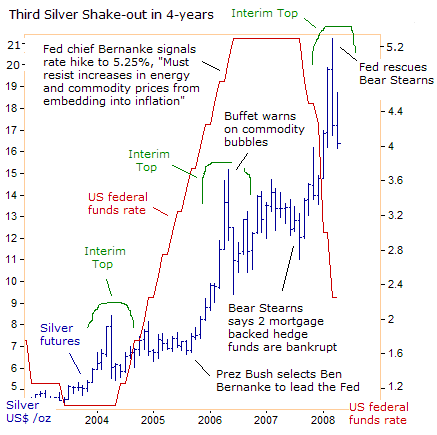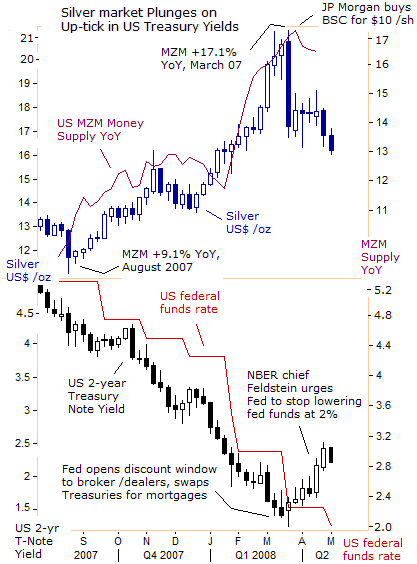|
|||
What's behind the Slide in Gold and Silver?Gary Dorsch After watching the price of silver soar to as high as $15 /ounce in May 2006, Warren Buffett, the "Oracle of Omaha" offered some sagely words of wisdom. "What the wise man does at the beginning, the fool does at the end. At the start of the party, the punch is flowing and everything's going well, but you know at midnight, it's all going to turn into pumpkins and mice. People think they'll be able to get out just before midnight, but everyone else thinks that too. The problem is that, in commodities there are no clocks on the wall," Buffett warned. Nine years earlier, in 1997, Buffett had begun accumulating 130-million ounces of silver, or nearly one-third of the entire world's supply, at roughly $4.50 per ounce for around $572 million. His public announcement of the silver purchases sent the price up to $7.50 an ounce from just under $6.00 in a few weeks. Then it was discovered that Mr. Buffett was taking delivery of March silver while selling July futures contracts. As quickly as silver prices soared, they plunged. But by May 2006, silver was spiraling higher again, doubling to $15 /oz, and Buffett lamented before his shareholders that he had sold his silver too early, and did not profit much from the sale. Still, Buffett's warning of a commodity bubble that was ready to deflate, was initially proven correct, when silver tumbled 32% and gold fell 24% over the next five weeks. Other key commodities such as copper and crude oil fell by a third by year's end from their peak levels that year.  Yet in hindsight, the perceived "bursting" of the silver bubble in May-June 2006, from a peak of $15 /oz, to as low as $10 /oz, was simply a wicked correction within the context of a long-term bull market. Fourteen months later, silver would mount another spectacular rally, this time to as high as $21.25 /oz, and surpassing the May 2006 high by 40 percent. Now, for the third time in the past four years, silver is undergoing yet another wicked correction from a spike top. The May-June 2006 slide in the silver market was triggered by a surprise rate hike by the Fed to 5.25%, above the perceived "neutral rate" of 5%, leaning on the side of restraint, to keep the powerful "Commodity Super Cycle" in check. Fed chief Ben "Helicopter" Bernanke was anxious to shed his dovish reputation after he had secretly confided to CNBC reporter Maria Bartiromo, "It's worrisome that people look at me as dovish and not as an aggressive inflation-fighter." Bernanke tried to reinvent himself as a hawk on June 1, 2006, when he told the International Monetary Conference in Washington, "The Fed will be vigilant to ensure that the recent pattern of elevated monthly core inflation readings is not sustained. The Fed must continue to resist any tendency for increases in energy and commodity prices to become permanently embedded in core inflation," he warned. Bernanke held the fed funds rate steady at 5.25% for more than a year, even as US home prices began their historic slide. Silver prices were locked in a sideways trading range, gyrating between $11 and $15 /ounce. But when startling revelations about the $1.8 trillion sub-prime mortgage crisis began to surface in the summer of 2007, threatening to topple Wall Street banks and brokers, Bernanke panicked and opened the money spigots, thus jettisoning the silver market to above $20 /oz.  Silver peaked on March 17th, near $21.25 /oz, coinciding with the Fed's eleventh hour rescue of Bear Stearns from bankruptcy. Since then, silver has tumbled 25% to $16 /oz, enduring its third major shake-out in the past four-years. Whereas the 2006 shake-out in the silver market was triggered by the Fed's surprising 0.25% rate hike to 5.25%, the latest slide is based on opposite ideas - that the Fed's rate cutting spree has arrived at a dead-end at 2 percent. In today's highly sophisticated financial marketplace, there is no longer any need to employ Federal Reserve officials to figure out the most appropriate target level for the federal funds rate. Instead, it's done by remote control, by traders in the US Treasury and Chicago interest-rate futures markets, who are usually several steps ahead of the political lackeys sitting at the Fed. A pause in the Fed's rate cutting campaign was signaled when yields on the US Treasury's two-year note moved above the 2.25% fed funds rate last week. Treasury yields jumped after NBER chief economist Martin Feldstein, a close confidant of Mr Bernanke, said on CNBC television., "It would make sense for the Fed to stop cutting its target rate at between 2% and the current 2.25%, because to go lower could exacerbate the problem of inflation emanating from high commodity prices." On April 9th, former Fed chief Paul Volcker lashed out at the Bernanke Fed's super-easy monetary policy, which has fueled the biggest commodity bubble since the 1970's. "When concerns about recession are rife, the central bank will be tempted to subordinate the fundamental need to maintain a reliable currency, to the impulse to shore up a flagging economy. The danger is that you lose both battles, as the US did in the 1970's, and wind up with stagflation," he warned. "The Fed has a particular duty to defend the integrity of the fiat currency in its charge," Volcker added. To read the rest of the article, click on the hyper-link below: http://www.sirchartsalot.com/article.php?id=84 May 1, 2008 |
